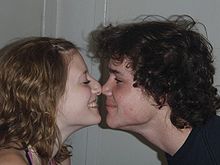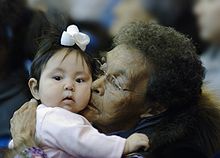
A kiss is the touch or pressing of one's lips against another person or an object. Cultural connotations of kissing vary widely. Depending on the culture and context, a kiss can express sentiments of love, passion, romance, sexual attraction, sexual activity, sexual arousal, affection, respect, greeting, peace, and good luck, among many others. In some situations, a kiss is a ritual, formal or symbolic gesture indicating devotion, respect, or a sacramental. The word came from Old English cyssan, in turn from coss.
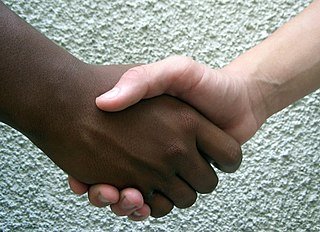
A handshake is a globally widespread, brief greeting or parting tradition in which two people grasp one of each other's hands, and in most cases, it is accompanied by a brief up-and-down movement of the grasped hands. Customs surrounding handshakes are specific to cultures. Different cultures may be more or less likely to shake hands, or there may be different customs about how or when to shake hands.

A hug is a form of endearment, found in virtually all human communities, in which two or more people put their arms around the neck, back, or waist of one another and hold each other closely. If more than two people are involved, it may be referred to as a group hug.

Greeting is an act of communication in which human beings intentionally make their presence known to each other, to show attention to, and to suggest a type of relationship or social status between individuals or groups of people coming in contact with each other. Greetings are sometimes used just prior to a conversation or to greet in passing, such as on a sidewalk or trail. While greeting customs are highly culture- and situation-specific and may change within a culture depending on social status and relationship, they exist in all known human cultures. Greetings can be expressed both audibly and physically, and often involve a combination of the two. This topic excludes military and ceremonial salutes but includes rituals other than gestures. A greeting, or salutation, can also be expressed in written communications, such as letters and emails.

Hand-kissing is a greeting gesture that indicates courtesy, politeness, respect, admiration, affection or even devotion by one person toward another. A hand-kiss is considered a respectful way for a gentleman to greet a lady. Today, non-ritual hand-kissing is rare and takes place mostly within conservative class or diplomatic contexts. Today, the hand kiss has largely been replaced by a kiss on the cheek or a handshake.

Cheek kissing is a ritual or social kissing gesture to indicate friendship, family relationship, perform a greeting, to confer congratulations, to comfort someone, or to show respect.
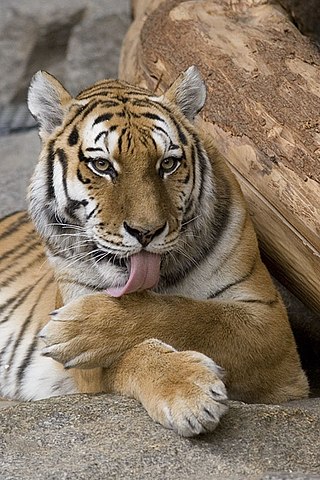
Licking is the action of passing the tongue over a surface, typically either to deposit saliva onto the surface, or to collect liquid, food or minerals onto the tongue for ingestion, or to communicate with other animals. Many animals both groom themselves, eat or drink by licking.
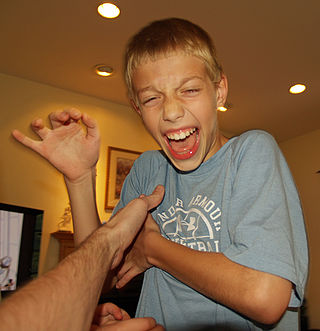
Haptic communication is a branch of nonverbal communication that refers to the ways in which people and animals communicate and interact via the sense of touch. Touch is the most sophisticated and intimate of the five senses. Touch or haptics, from the ancient Greek word haptikos is extremely important for communication; it is vital for survival.

The hongi is a traditional Māori greeting performed by two people pressing their noses together, often including the touching of the foreheads. The greeting is used at traditional meetings among Māori people, and at major ceremonies, such as a pōwhiri. It may be followed by a handshake.

Cats communicate for a variety of reasons, including to show happiness, express anger, solicit attention, and observe potential prey. Additionally, they collaborate, play, and share resources. When cats communicate with humans, they do so to get what they need or want, such as food, water, attention, or play. As such, cat communication methods have been significantly altered by domestication. Studies have shown that domestic cats tend to meow much more than feral cats. They rarely meow to communicate with fellow cats or other animals. Cats can socialize with each other and are known to form "social ladders," where a dominant cat is leading a few lesser cats. This is common in multi-cat households.

Stereotypes of Indigenous peoples of Canada and the United States of America include many ethnic stereotypes found worldwide which include historical misrepresentations and the oversimplification of hundreds of Indigenous cultures. Negative stereotypes are associated with prejudice and discrimination that continue to affect the lives of Indigenous peoples.
Eskimo, is an exonym for the Inuit and Yupik indigenous peoples who have traditionally inhabited the northern circumpolar region from eastern Siberia (Russia), across Alaska, Canada, and Greenland.
Etiquette in Latin America varies by country and by region within a given country.
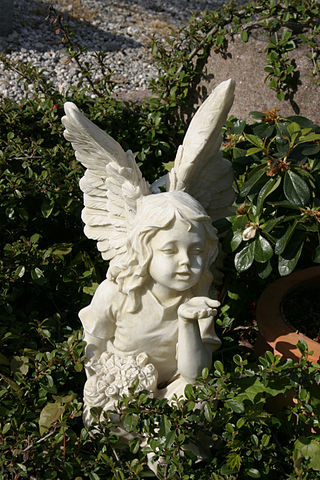
An air kiss, blown kiss, or thrown kiss is a ritual or social gesture whose meaning is basically the same as that of many forms of kissing. The air kiss is a pretence of kissing: the lips are pursed as if kissing, but without actually touching the other person's body. Sometimes, the air kiss includes touching cheek-to-cheek. Also, the gesture may be accompanied by the mwah sound. The onomatopoeic word mwah has entered Webster's dictionary.

Non-penetrative sex or outercourse is sexual activity that usually does not include sexual penetration. It generally excludes the penetrative aspects of vaginal, anal, or oral sex, but includes various forms of sexual and non-sexual activity, such as frottage, manual sex, mutual masturbation, kissing, or cuddling. Some forms of non-penetrative sex, particularly when termed outercourse, include penetrative aspects, such as penetration that may result from forms of fingering or oral sex.
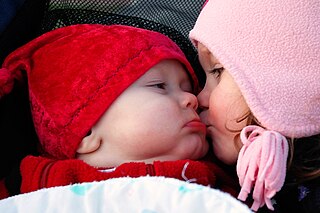
Many societies have traditions which involve kissing. Kissing can indicate joy or be used as part of a greeting. Kissing involves the touching of one's lips to the lips or other body part, such as the cheek, head or hand of another person. Sometimes people often kiss their friends as a way of giving luck or even showing feelings.

The allergic salute is the characteristic and sometimes habitual gesture of wiping and/or rubbing the nose in an upwards or transverse manner with the fingers, palm, or back of the hand. It is termed a salute because the upward movement of the hand acts as an unintentional gesture. The habit of using the hand to wipe the nose is observed more often in children but is common in adults as well. Saluting most commonly temporarily relieves nasal itching as well as removing small amounts of nasal mucus.

Yup'ik doll is a traditional Eskimo style doll and figurine form made in the southwestern Alaska by Yup'ik people. Also known as Cup'ik doll for the Chevak Cup'ik dialect speaking Eskimos of Chevak and Cup'ig doll for the Nunivak Cup'ig dialect speaking Eskimos of Nunivak Island. Typically, Yup'ik dolls are dressed in traditional Eskimo style Yup'ik clothing, intended to protect the wearer from cold weather, and are often made from traditional materials obtained through food gathering. Play dolls from the Yup'ik area were made of wood, bone, or walrus ivory and measured from one to twelve inches in height or more. Male and female dolls were often distinguished anatomically and can be told apart by the addition of ivory labrets for males and chin tattooing for females. The information about play dolls within Alaska Native cultures is sporadic. As is so often the case in early museum collections, it is difficult to distinguish dolls made for play from those made for ritual. There were always five dolls making up a family: a father, a mother, a son, a daughter, and a baby. Some human figurines were used by shamans.

Statue rubbing is the act of touching a part of a public statue. Popular among tourists, it is a form of superstition that is believed to bring good luck, ensure a return to the city, improve love life or make a wish come true.
